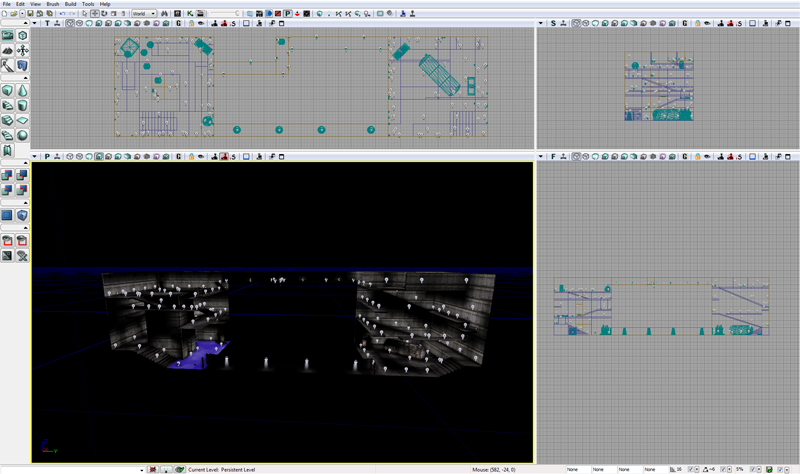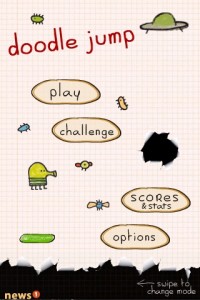by Annie | Sep 1, 2010 | Game Design
Solid game design rests on a thorough grasp of psychology. If we can start to understand what motivates us in real life, we can create games that motivate us, and vice versa. Combine game motivation and real life motivation, and you’ll get some really motivated people. Take a...

by Annie | Aug 31, 2010 | Game Design
Creating a level from scratch can be fun. You get to decide where to put different obstacles, how to guide players, and when to provide rewards. Creating a level using unfamiliar technology, however, can be downright intimidating. Recently, we started using UDK (Unreal Development Kit), a game engine created by Epic Games that provided the basis for games like Gears of War, Bioshock, and Mass Effect. Luckily, with a manageable assignment and supportive instructors, our first experience in the UDK pool was more of a gentle splash rather than an embarrassing and painful belly flop. When working in UDK, you can build through a variety a views: top, side, front, and perspective. This is all to ensure that the assets are integrated seamlessly, providing total gameplay immersion. Our assignment was simple: create two rooms linked by two corridors. Here are a few screenshots from the level I created: Hopefully, with more practice, I’ll soon be able to create entire cities in UDK. Stay...

by Annie | Aug 30, 2010 | Game Design
It seems that I’m a bit late to the Doodle Jump boat, but I’m no less addicted. Like the millions of Doodle Jump fans around the world, I’ve logged countless hours guiding Doodle up an endless path of platforms, dodging alien monsters and hoping for boosts from rockets and propeller hats. Doodle Jump advertises itself as “Doodle Jump – BE WARNED: Insanely Addictive!” and does not fail to deliver. But why? How can something so simple be so addicting to so many people? For those of you who aren’t familiar with Doodle Jump, it’s a platform game created by Lima Sky that was released worldwide in April of 2009. By June of 2010, the game had already sold over 5 million copies, continuing to generate nearly 30,000 downloads a day. At this point, you might be thinking that the game must be epic. Dozens of levels, tons of tough enemies, tricky puzzles, customization galore. But you’d be wrong. Gameplay consists of guiding a green four-legged creature up an endless array of platforms without falling. The higher Doodle gets, the higher your score. That’s it. So back to my original question. Why is that fun? And more importantly, why is that repeatedly fun? Such a simple and repetitive action could get boring fast, but this game is different. There seem to be a lot of hidden factors that make Doodle Jump the runaway success that it is. Here are my takes on why the game is so fun: 1. Doodle Jump is easy to learn. Learning how to play Doodle Jump takes less than 5 seconds. Doodle’s movement up the...
by Annie | Aug 29, 2010 | Game Design
Ready or not, games are getting ready to take over the world. People all over the world are starting to recognize and leverage the power of games to influence behavior. Soon, school, work, cooking, shopping, and free time will all be tied to games. As Seth Priebatsch says in his TED talk, “Last decade was the decade of social. This next decade is the decade of...

by Annie | Aug 27, 2010 | Game Design
Most people who know me well are privy to my love of math and logic puzzles. I do sudoku puzzles in my spare time and take huge books of logic puzzles with me on long flights. So when it was time to design a board game, what did I do? You guessed it – a math game. Math was by far my favorite subject to teach during my years in the classroom. Math is built on a framework of simple rules that anyone can grasp. Throw in a little practice, and you’ll be a math whiz in no time. I had students who started the year barely able to multiply 2×2. By the end, most were able to recite the times tables through 9 and complete fairly complicated long division problems. Now, one thing you should know is that I didn’t set out to create an educational board game. Sure, I came to VFS to study game design in an effort to eventually create educational games, but I didn’t feel the need to combine gaming and education right away. However, it caught up with me anyway. I started out with an idea involving dice. You roll the dice, then mark a multiple of that number on a grid in an effort to get five numbers in a row. That got boring pretty fast. Next, I went a completely different route. I tried to come up with a spider web game in which players build webs and then set traps for each other while trying to capture prey. That one was a little too complicated to get just right. After...



